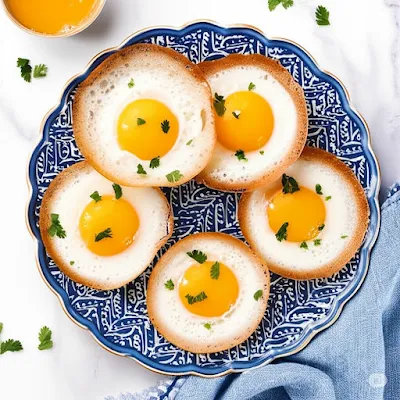Sri Lanka’s Most Delicious Egg Hopper Recipe (Bitha Appa)
🥚 Crispy, Lacy & Loaded with Flavor!
If you're dreaming of a breakfast that’s crispy on the outside, soft in the middle, and filled with a golden egg, you’re in for a treat! This Sri Lankan Egg Hopper recipe is the ultimate fusion of flavor, texture, and tradition. Whether you're new to Sri Lankan cuisine or just looking for a unique and delicious dish, egg hoppers (locally known as Bitha Appa) will leave you wanting more.
📌 What Are Egg Hoppers?
Egg Hoppers are a popular Sri Lankan breakfast or dinner dish made from a fermented rice flour and coconut milk batter. They're cooked in small round pans, resulting in thin, crispy edges and a soft, fluffy center. Right before the hopper finishes cooking, an egg is cracked into the middle—creating a rich and savory twist!
💡 Mindset – Why You Should Make Egg Hoppers
You might be stuck in a routine—eating the same toast and eggs every day. Maybe you’ve heard about Sri Lankan food but never tried making it at home. Here’s the truth: cooking egg hoppers is easier than you think, and the results are stunning.
Not only are egg hoppers beautiful and flavorful, but they also bring variety, culture, and joy to your plate. By making them, you get to enjoy a delicious meal that connects you with the vibrant street food culture of Sri Lanka—right in your own kitchen.
👨🍳 Behavior – How to Make Sri Lankan Egg Hoppers
✅ Ingredients
For the hopper batter:
-
2 cups white rice (soaked for 4 hours)
-
1 cup thick coconut milk
-
1 tsp sugar
-
1 tsp dry yeast
-
¼ tsp baking soda
-
½ tsp salt
-
Water as needed
For cooking:
-
4-6 fresh eggs
-
Coconut oil (for greasing the pan)
🔄 Step-by-Step Instructions
Step 1: Prepare the Batter
Step 2: Cook the Hoppers
Step 3: Add the Egg
Step 4: Cook Until Done
Step 5: Serve
🌟 Consequence – What You’ll Gain
By making egg hoppers, you’re not just preparing food—you’re creating an experience. You’ll:
-
Impress family and friends with a unique Sri Lankan breakfast.
-
Enjoy a healthy mix of carbs, protein, and good fats.
-
Break the breakfast boredom with something crispy, creamy, and satisfying.
-
Gain confidence in cooking global cuisine from scratch.
🙌 Final Thoughts
Sri Lankan Egg Hoppers are more than just food—they’re a cultural experience on a plate. With their crispy texture, savory egg center, and delicate flavor, they’re perfect for anyone looking to try something new and unforgettable.
Now that you’ve learned the recipe, it’s time to grab your hopper pan and get cooking. You’ll be surprised at how fun—and tasty—this journey is!



.jpeg)

.jpeg)
